Apple's Organizational Structure: Factors, Dynamics, and Growth
VerifiedAdded on 2022/12/26
|8
|2522
|62
Report
AI Summary
This report provides a detailed analysis of Apple Inc.'s organizational structure, examining the factors that influence its design and evolution. It begins with an introduction to organizational structure and its importance, followed by an in-depth discussion of the key factors impacting Apple's structure, including life cycle, size, strategies, environment, and technology. The report then explores the characteristics of Apple's divisional and functional matrix structures, highlighting the roles of leadership, including Steve Jobs and Tim Cook, and how these structures facilitate innovation and collaboration. Furthermore, the report examines how Apple manages the dynamic processes that shape its growth and evolution, focusing on organizational culture, leadership styles, and the role of innovation in maintaining a competitive edge. The conclusion summarizes the critical role of organizational structure in Apple's overall performance and its ability to thrive in the competitive technology market.
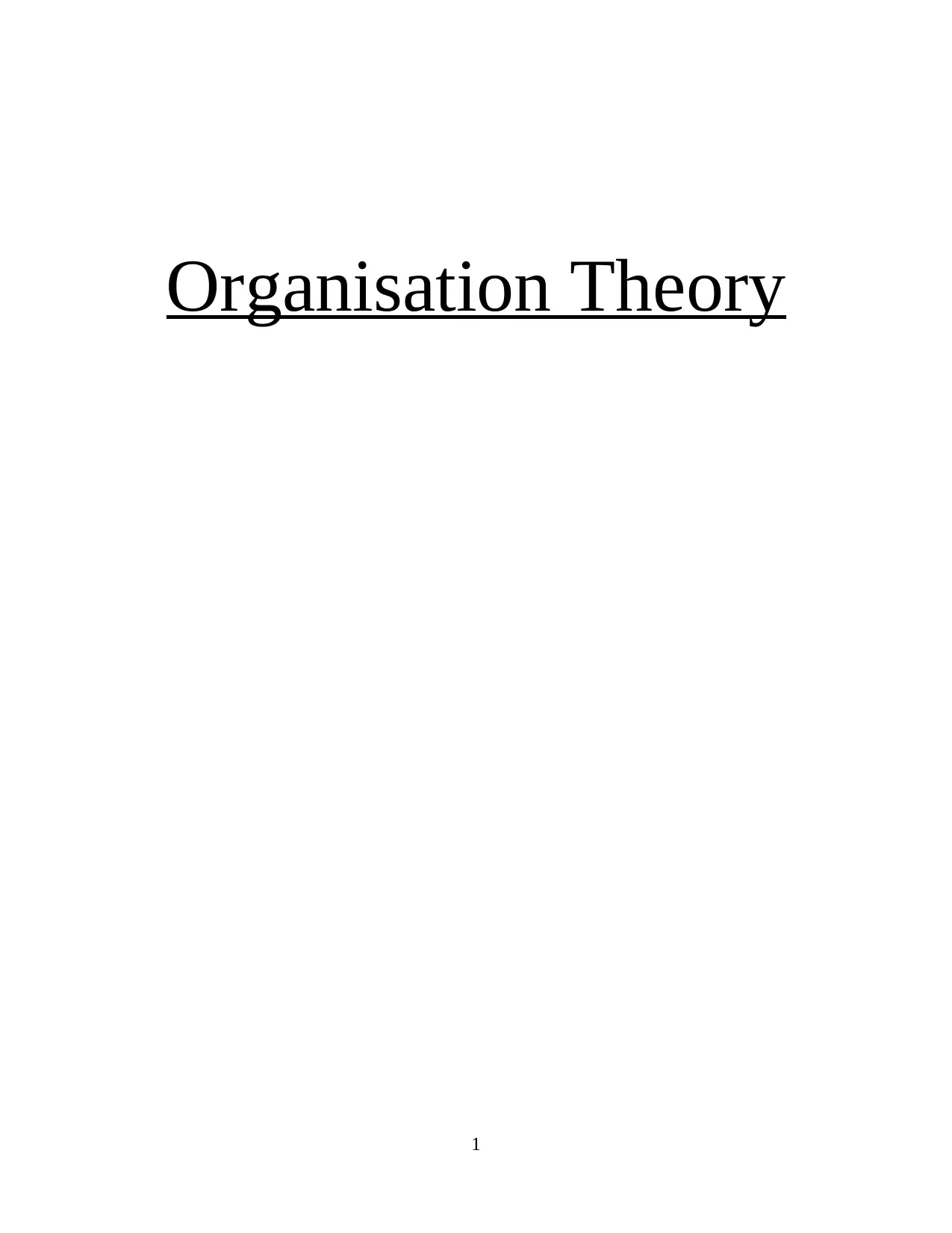
Organisation Theory
1
1
Paraphrase This Document
Need a fresh take? Get an instant paraphrase of this document with our AI Paraphraser

Contents
Introduction......................................................................................................................................3
Main Body.......................................................................................................................................3
DIFFERENT FACTORS THAT INFLUENCE THE ORGANISATIONAL STRUCTURE OF
APPLE........................................................................................................................................3
CHARACTERISTIC OF DIVISIONAL AND FUNCTIOMNAL MATRIX STRUCTURE
OF APPLE..................................................................................................................................4
HOW APPLE MANAGES THE DYNAMIC PROCESS THAT SHAPE THEIR GROWTH
AND EVOLUTION....................................................................................................................5
Conclusion.......................................................................................................................................7
References........................................................................................................................................8
2
Introduction......................................................................................................................................3
Main Body.......................................................................................................................................3
DIFFERENT FACTORS THAT INFLUENCE THE ORGANISATIONAL STRUCTURE OF
APPLE........................................................................................................................................3
CHARACTERISTIC OF DIVISIONAL AND FUNCTIOMNAL MATRIX STRUCTURE
OF APPLE..................................................................................................................................4
HOW APPLE MANAGES THE DYNAMIC PROCESS THAT SHAPE THEIR GROWTH
AND EVOLUTION....................................................................................................................5
Conclusion.......................................................................................................................................7
References........................................................................................................................................8
2
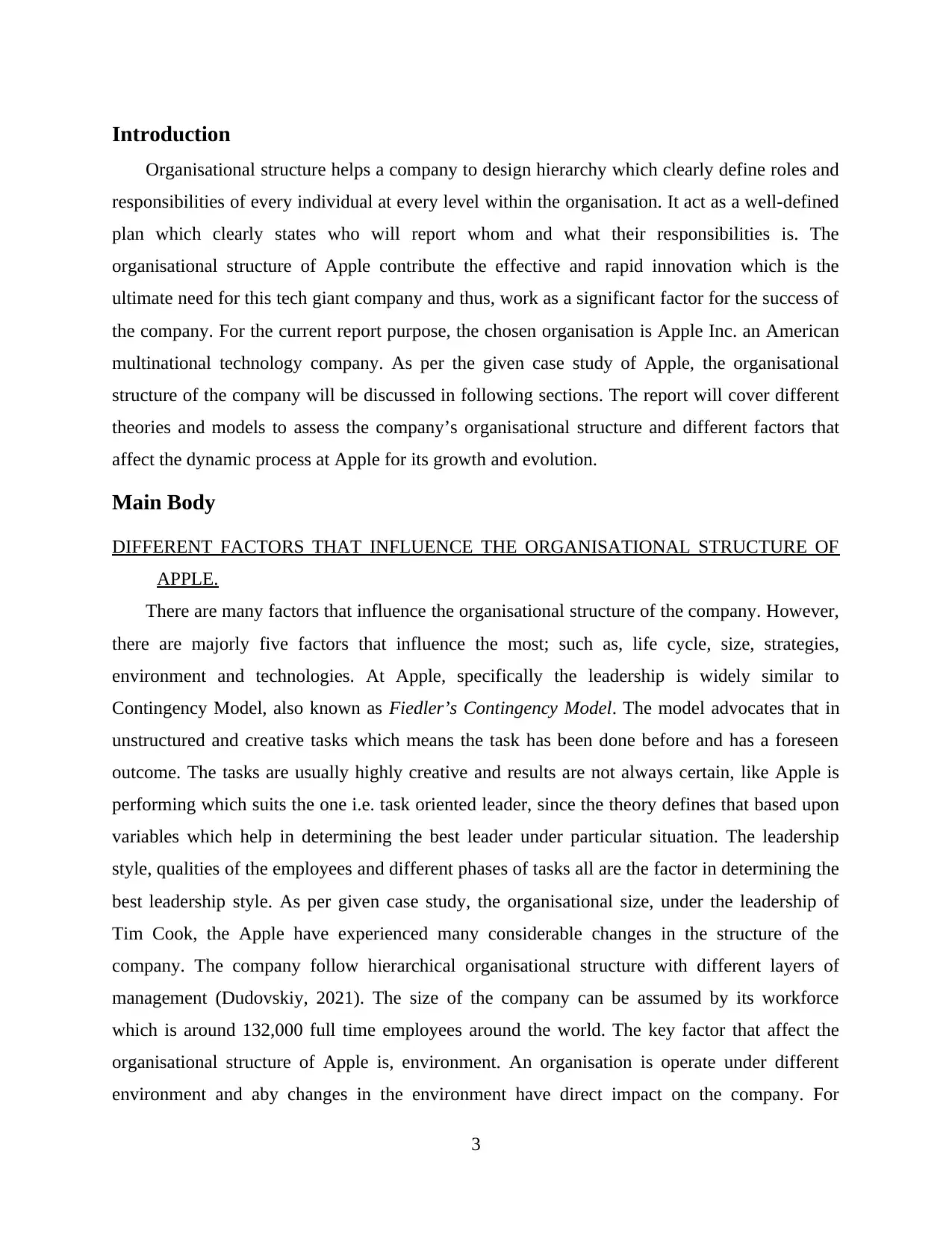
Introduction
Organisational structure helps a company to design hierarchy which clearly define roles and
responsibilities of every individual at every level within the organisation. It act as a well-defined
plan which clearly states who will report whom and what their responsibilities is. The
organisational structure of Apple contribute the effective and rapid innovation which is the
ultimate need for this tech giant company and thus, work as a significant factor for the success of
the company. For the current report purpose, the chosen organisation is Apple Inc. an American
multinational technology company. As per the given case study of Apple, the organisational
structure of the company will be discussed in following sections. The report will cover different
theories and models to assess the company’s organisational structure and different factors that
affect the dynamic process at Apple for its growth and evolution.
Main Body
DIFFERENT FACTORS THAT INFLUENCE THE ORGANISATIONAL STRUCTURE OF
APPLE.
There are many factors that influence the organisational structure of the company. However,
there are majorly five factors that influence the most; such as, life cycle, size, strategies,
environment and technologies. At Apple, specifically the leadership is widely similar to
Contingency Model, also known as Fiedler’s Contingency Model. The model advocates that in
unstructured and creative tasks which means the task has been done before and has a foreseen
outcome. The tasks are usually highly creative and results are not always certain, like Apple is
performing which suits the one i.e. task oriented leader, since the theory defines that based upon
variables which help in determining the best leader under particular situation. The leadership
style, qualities of the employees and different phases of tasks all are the factor in determining the
best leadership style. As per given case study, the organisational size, under the leadership of
Tim Cook, the Apple have experienced many considerable changes in the structure of the
company. The company follow hierarchical organisational structure with different layers of
management (Dudovskiy, 2021). The size of the company can be assumed by its workforce
which is around 132,000 full time employees around the world. The key factor that affect the
organisational structure of Apple is, environment. An organisation is operate under different
environment and aby changes in the environment have direct impact on the company. For
3
Organisational structure helps a company to design hierarchy which clearly define roles and
responsibilities of every individual at every level within the organisation. It act as a well-defined
plan which clearly states who will report whom and what their responsibilities is. The
organisational structure of Apple contribute the effective and rapid innovation which is the
ultimate need for this tech giant company and thus, work as a significant factor for the success of
the company. For the current report purpose, the chosen organisation is Apple Inc. an American
multinational technology company. As per the given case study of Apple, the organisational
structure of the company will be discussed in following sections. The report will cover different
theories and models to assess the company’s organisational structure and different factors that
affect the dynamic process at Apple for its growth and evolution.
Main Body
DIFFERENT FACTORS THAT INFLUENCE THE ORGANISATIONAL STRUCTURE OF
APPLE.
There are many factors that influence the organisational structure of the company. However,
there are majorly five factors that influence the most; such as, life cycle, size, strategies,
environment and technologies. At Apple, specifically the leadership is widely similar to
Contingency Model, also known as Fiedler’s Contingency Model. The model advocates that in
unstructured and creative tasks which means the task has been done before and has a foreseen
outcome. The tasks are usually highly creative and results are not always certain, like Apple is
performing which suits the one i.e. task oriented leader, since the theory defines that based upon
variables which help in determining the best leader under particular situation. The leadership
style, qualities of the employees and different phases of tasks all are the factor in determining the
best leadership style. As per given case study, the organisational size, under the leadership of
Tim Cook, the Apple have experienced many considerable changes in the structure of the
company. The company follow hierarchical organisational structure with different layers of
management (Dudovskiy, 2021). The size of the company can be assumed by its workforce
which is around 132,000 full time employees around the world. The key factor that affect the
organisational structure of Apple is, environment. An organisation is operate under different
environment and aby changes in the environment have direct impact on the company. For
3
⊘ This is a preview!⊘
Do you want full access?
Subscribe today to unlock all pages.

Trusted by 1+ million students worldwide
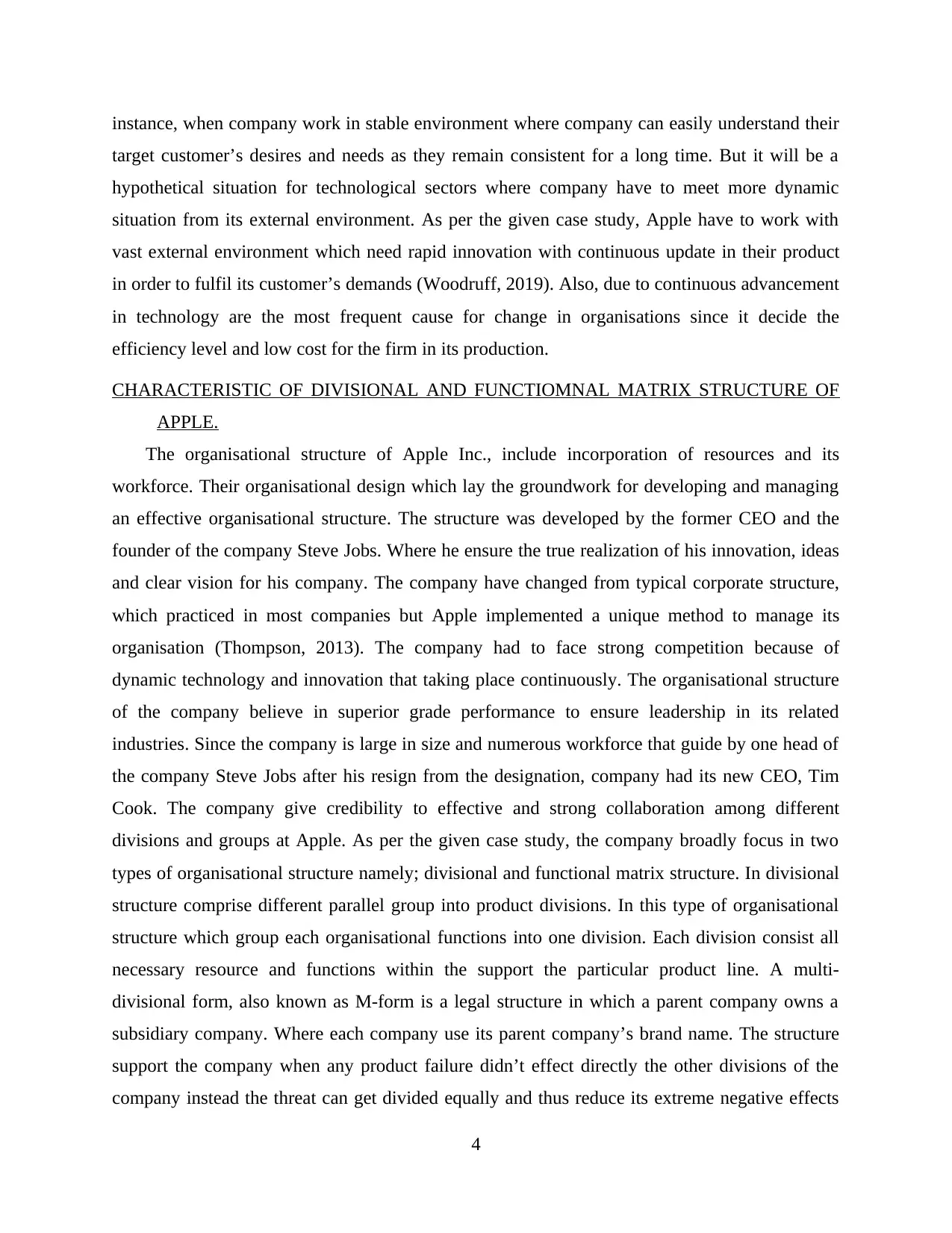
instance, when company work in stable environment where company can easily understand their
target customer’s desires and needs as they remain consistent for a long time. But it will be a
hypothetical situation for technological sectors where company have to meet more dynamic
situation from its external environment. As per the given case study, Apple have to work with
vast external environment which need rapid innovation with continuous update in their product
in order to fulfil its customer’s demands (Woodruff, 2019). Also, due to continuous advancement
in technology are the most frequent cause for change in organisations since it decide the
efficiency level and low cost for the firm in its production.
CHARACTERISTIC OF DIVISIONAL AND FUNCTIOMNAL MATRIX STRUCTURE OF
APPLE.
The organisational structure of Apple Inc., include incorporation of resources and its
workforce. Their organisational design which lay the groundwork for developing and managing
an effective organisational structure. The structure was developed by the former CEO and the
founder of the company Steve Jobs. Where he ensure the true realization of his innovation, ideas
and clear vision for his company. The company have changed from typical corporate structure,
which practiced in most companies but Apple implemented a unique method to manage its
organisation (Thompson, 2013). The company had to face strong competition because of
dynamic technology and innovation that taking place continuously. The organisational structure
of the company believe in superior grade performance to ensure leadership in its related
industries. Since the company is large in size and numerous workforce that guide by one head of
the company Steve Jobs after his resign from the designation, company had its new CEO, Tim
Cook. The company give credibility to effective and strong collaboration among different
divisions and groups at Apple. As per the given case study, the company broadly focus in two
types of organisational structure namely; divisional and functional matrix structure. In divisional
structure comprise different parallel group into product divisions. In this type of organisational
structure which group each organisational functions into one division. Each division consist all
necessary resource and functions within the support the particular product line. A multi-
divisional form, also known as M-form is a legal structure in which a parent company owns a
subsidiary company. Where each company use its parent company’s brand name. The structure
support the company when any product failure didn’t effect directly the other divisions of the
company instead the threat can get divided equally and thus reduce its extreme negative effects
4
target customer’s desires and needs as they remain consistent for a long time. But it will be a
hypothetical situation for technological sectors where company have to meet more dynamic
situation from its external environment. As per the given case study, Apple have to work with
vast external environment which need rapid innovation with continuous update in their product
in order to fulfil its customer’s demands (Woodruff, 2019). Also, due to continuous advancement
in technology are the most frequent cause for change in organisations since it decide the
efficiency level and low cost for the firm in its production.
CHARACTERISTIC OF DIVISIONAL AND FUNCTIOMNAL MATRIX STRUCTURE OF
APPLE.
The organisational structure of Apple Inc., include incorporation of resources and its
workforce. Their organisational design which lay the groundwork for developing and managing
an effective organisational structure. The structure was developed by the former CEO and the
founder of the company Steve Jobs. Where he ensure the true realization of his innovation, ideas
and clear vision for his company. The company have changed from typical corporate structure,
which practiced in most companies but Apple implemented a unique method to manage its
organisation (Thompson, 2013). The company had to face strong competition because of
dynamic technology and innovation that taking place continuously. The organisational structure
of the company believe in superior grade performance to ensure leadership in its related
industries. Since the company is large in size and numerous workforce that guide by one head of
the company Steve Jobs after his resign from the designation, company had its new CEO, Tim
Cook. The company give credibility to effective and strong collaboration among different
divisions and groups at Apple. As per the given case study, the company broadly focus in two
types of organisational structure namely; divisional and functional matrix structure. In divisional
structure comprise different parallel group into product divisions. In this type of organisational
structure which group each organisational functions into one division. Each division consist all
necessary resource and functions within the support the particular product line. A multi-
divisional form, also known as M-form is a legal structure in which a parent company owns a
subsidiary company. Where each company use its parent company’s brand name. The structure
support the company when any product failure didn’t effect directly the other divisions of the
company instead the threat can get divided equally and thus reduce its extreme negative effects
4
Paraphrase This Document
Need a fresh take? Get an instant paraphrase of this document with our AI Paraphraser
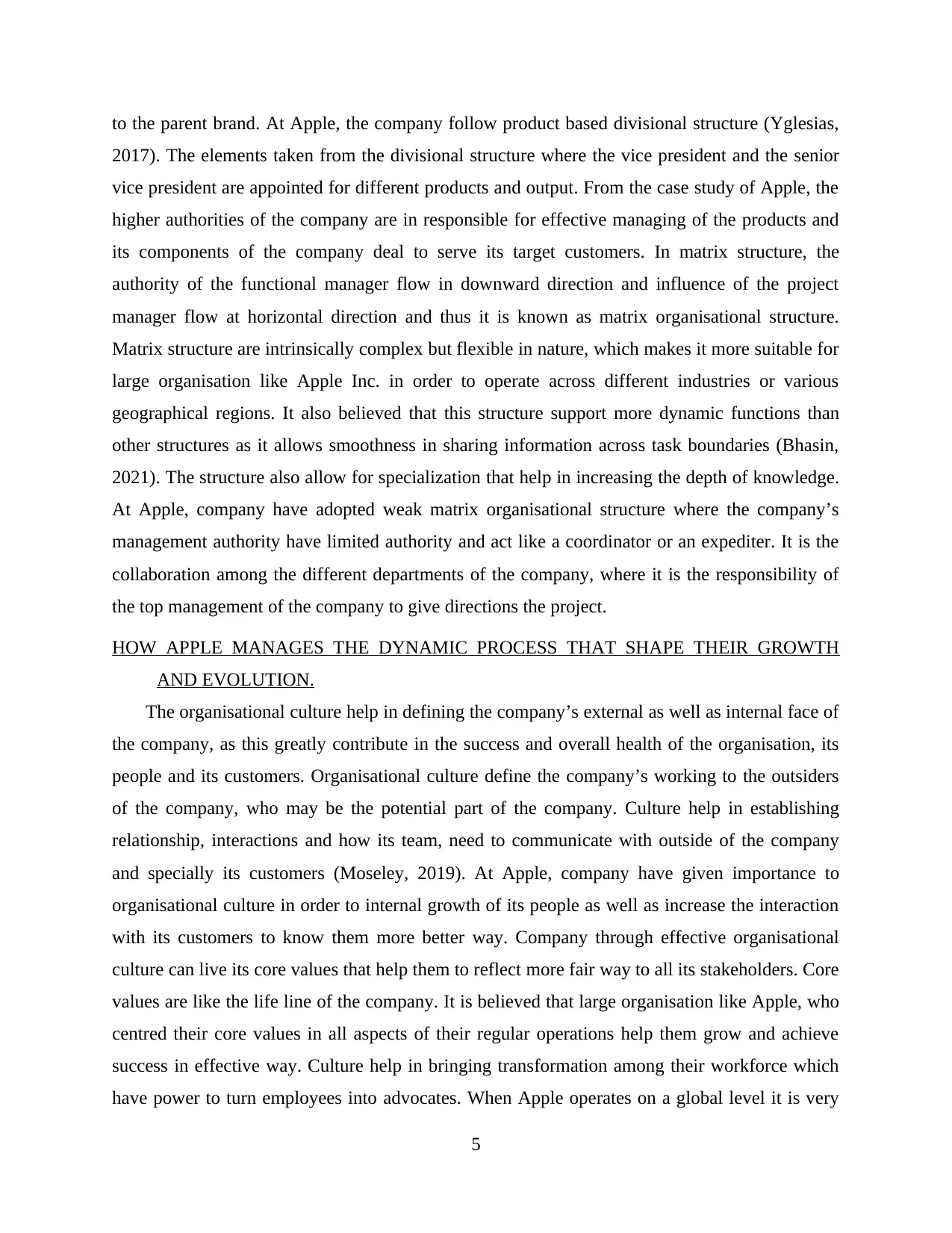
to the parent brand. At Apple, the company follow product based divisional structure (Yglesias,
2017). The elements taken from the divisional structure where the vice president and the senior
vice president are appointed for different products and output. From the case study of Apple, the
higher authorities of the company are in responsible for effective managing of the products and
its components of the company deal to serve its target customers. In matrix structure, the
authority of the functional manager flow in downward direction and influence of the project
manager flow at horizontal direction and thus it is known as matrix organisational structure.
Matrix structure are intrinsically complex but flexible in nature, which makes it more suitable for
large organisation like Apple Inc. in order to operate across different industries or various
geographical regions. It also believed that this structure support more dynamic functions than
other structures as it allows smoothness in sharing information across task boundaries (Bhasin,
2021). The structure also allow for specialization that help in increasing the depth of knowledge.
At Apple, company have adopted weak matrix organisational structure where the company’s
management authority have limited authority and act like a coordinator or an expediter. It is the
collaboration among the different departments of the company, where it is the responsibility of
the top management of the company to give directions the project.
HOW APPLE MANAGES THE DYNAMIC PROCESS THAT SHAPE THEIR GROWTH
AND EVOLUTION.
The organisational culture help in defining the company’s external as well as internal face of
the company, as this greatly contribute in the success and overall health of the organisation, its
people and its customers. Organisational culture define the company’s working to the outsiders
of the company, who may be the potential part of the company. Culture help in establishing
relationship, interactions and how its team, need to communicate with outside of the company
and specially its customers (Moseley, 2019). At Apple, company have given importance to
organisational culture in order to internal growth of its people as well as increase the interaction
with its customers to know them more better way. Company through effective organisational
culture can live its core values that help them to reflect more fair way to all its stakeholders. Core
values are like the life line of the company. It is believed that large organisation like Apple, who
centred their core values in all aspects of their regular operations help them grow and achieve
success in effective way. Culture help in bringing transformation among their workforce which
have power to turn employees into advocates. When Apple operates on a global level it is very
5
2017). The elements taken from the divisional structure where the vice president and the senior
vice president are appointed for different products and output. From the case study of Apple, the
higher authorities of the company are in responsible for effective managing of the products and
its components of the company deal to serve its target customers. In matrix structure, the
authority of the functional manager flow in downward direction and influence of the project
manager flow at horizontal direction and thus it is known as matrix organisational structure.
Matrix structure are intrinsically complex but flexible in nature, which makes it more suitable for
large organisation like Apple Inc. in order to operate across different industries or various
geographical regions. It also believed that this structure support more dynamic functions than
other structures as it allows smoothness in sharing information across task boundaries (Bhasin,
2021). The structure also allow for specialization that help in increasing the depth of knowledge.
At Apple, company have adopted weak matrix organisational structure where the company’s
management authority have limited authority and act like a coordinator or an expediter. It is the
collaboration among the different departments of the company, where it is the responsibility of
the top management of the company to give directions the project.
HOW APPLE MANAGES THE DYNAMIC PROCESS THAT SHAPE THEIR GROWTH
AND EVOLUTION.
The organisational culture help in defining the company’s external as well as internal face of
the company, as this greatly contribute in the success and overall health of the organisation, its
people and its customers. Organisational culture define the company’s working to the outsiders
of the company, who may be the potential part of the company. Culture help in establishing
relationship, interactions and how its team, need to communicate with outside of the company
and specially its customers (Moseley, 2019). At Apple, company have given importance to
organisational culture in order to internal growth of its people as well as increase the interaction
with its customers to know them more better way. Company through effective organisational
culture can live its core values that help them to reflect more fair way to all its stakeholders. Core
values are like the life line of the company. It is believed that large organisation like Apple, who
centred their core values in all aspects of their regular operations help them grow and achieve
success in effective way. Culture help in bringing transformation among their workforce which
have power to turn employees into advocates. When Apple operates on a global level it is very
5
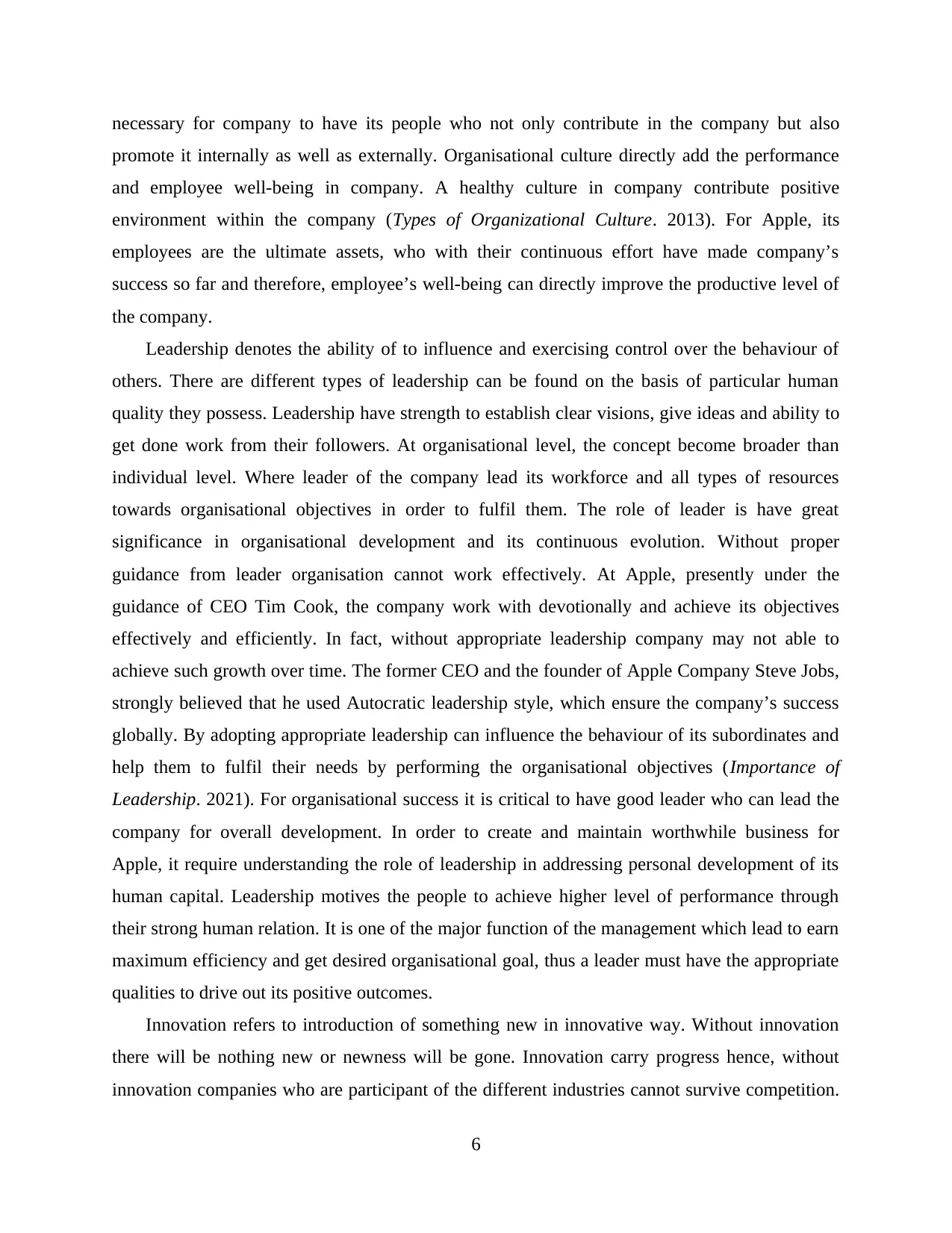
necessary for company to have its people who not only contribute in the company but also
promote it internally as well as externally. Organisational culture directly add the performance
and employee well-being in company. A healthy culture in company contribute positive
environment within the company (Types of Organizational Culture. 2013). For Apple, its
employees are the ultimate assets, who with their continuous effort have made company’s
success so far and therefore, employee’s well-being can directly improve the productive level of
the company.
Leadership denotes the ability of to influence and exercising control over the behaviour of
others. There are different types of leadership can be found on the basis of particular human
quality they possess. Leadership have strength to establish clear visions, give ideas and ability to
get done work from their followers. At organisational level, the concept become broader than
individual level. Where leader of the company lead its workforce and all types of resources
towards organisational objectives in order to fulfil them. The role of leader is have great
significance in organisational development and its continuous evolution. Without proper
guidance from leader organisation cannot work effectively. At Apple, presently under the
guidance of CEO Tim Cook, the company work with devotionally and achieve its objectives
effectively and efficiently. In fact, without appropriate leadership company may not able to
achieve such growth over time. The former CEO and the founder of Apple Company Steve Jobs,
strongly believed that he used Autocratic leadership style, which ensure the company’s success
globally. By adopting appropriate leadership can influence the behaviour of its subordinates and
help them to fulfil their needs by performing the organisational objectives (Importance of
Leadership. 2021). For organisational success it is critical to have good leader who can lead the
company for overall development. In order to create and maintain worthwhile business for
Apple, it require understanding the role of leadership in addressing personal development of its
human capital. Leadership motives the people to achieve higher level of performance through
their strong human relation. It is one of the major function of the management which lead to earn
maximum efficiency and get desired organisational goal, thus a leader must have the appropriate
qualities to drive out its positive outcomes.
Innovation refers to introduction of something new in innovative way. Without innovation
there will be nothing new or newness will be gone. Innovation carry progress hence, without
innovation companies who are participant of the different industries cannot survive competition.
6
promote it internally as well as externally. Organisational culture directly add the performance
and employee well-being in company. A healthy culture in company contribute positive
environment within the company (Types of Organizational Culture. 2013). For Apple, its
employees are the ultimate assets, who with their continuous effort have made company’s
success so far and therefore, employee’s well-being can directly improve the productive level of
the company.
Leadership denotes the ability of to influence and exercising control over the behaviour of
others. There are different types of leadership can be found on the basis of particular human
quality they possess. Leadership have strength to establish clear visions, give ideas and ability to
get done work from their followers. At organisational level, the concept become broader than
individual level. Where leader of the company lead its workforce and all types of resources
towards organisational objectives in order to fulfil them. The role of leader is have great
significance in organisational development and its continuous evolution. Without proper
guidance from leader organisation cannot work effectively. At Apple, presently under the
guidance of CEO Tim Cook, the company work with devotionally and achieve its objectives
effectively and efficiently. In fact, without appropriate leadership company may not able to
achieve such growth over time. The former CEO and the founder of Apple Company Steve Jobs,
strongly believed that he used Autocratic leadership style, which ensure the company’s success
globally. By adopting appropriate leadership can influence the behaviour of its subordinates and
help them to fulfil their needs by performing the organisational objectives (Importance of
Leadership. 2021). For organisational success it is critical to have good leader who can lead the
company for overall development. In order to create and maintain worthwhile business for
Apple, it require understanding the role of leadership in addressing personal development of its
human capital. Leadership motives the people to achieve higher level of performance through
their strong human relation. It is one of the major function of the management which lead to earn
maximum efficiency and get desired organisational goal, thus a leader must have the appropriate
qualities to drive out its positive outcomes.
Innovation refers to introduction of something new in innovative way. Without innovation
there will be nothing new or newness will be gone. Innovation carry progress hence, without
innovation companies who are participant of the different industries cannot survive competition.
6
⊘ This is a preview!⊘
Do you want full access?
Subscribe today to unlock all pages.

Trusted by 1+ million students worldwide
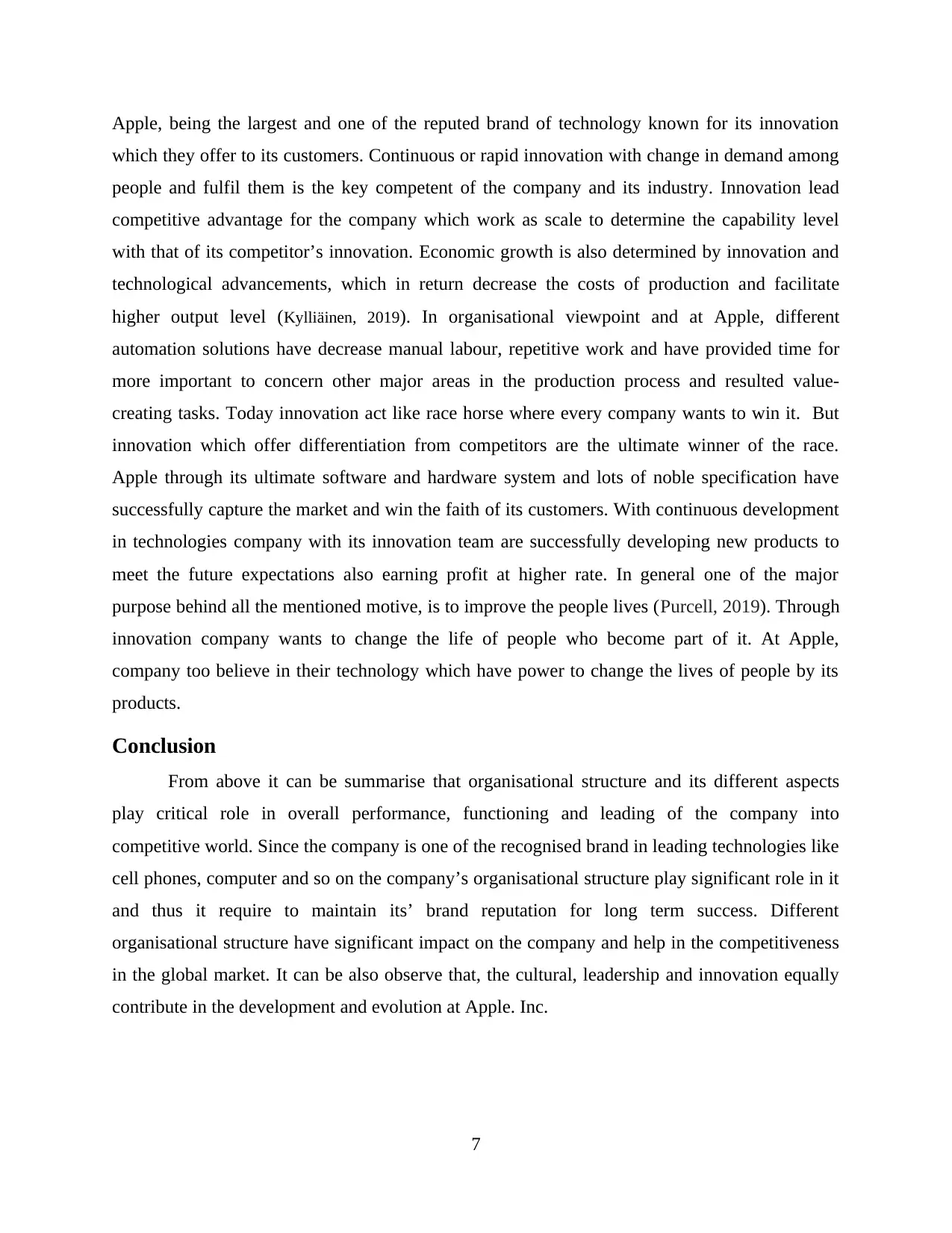
Apple, being the largest and one of the reputed brand of technology known for its innovation
which they offer to its customers. Continuous or rapid innovation with change in demand among
people and fulfil them is the key competent of the company and its industry. Innovation lead
competitive advantage for the company which work as scale to determine the capability level
with that of its competitor’s innovation. Economic growth is also determined by innovation and
technological advancements, which in return decrease the costs of production and facilitate
higher output level (Kylliäinen, 2019). In organisational viewpoint and at Apple, different
automation solutions have decrease manual labour, repetitive work and have provided time for
more important to concern other major areas in the production process and resulted value-
creating tasks. Today innovation act like race horse where every company wants to win it. But
innovation which offer differentiation from competitors are the ultimate winner of the race.
Apple through its ultimate software and hardware system and lots of noble specification have
successfully capture the market and win the faith of its customers. With continuous development
in technologies company with its innovation team are successfully developing new products to
meet the future expectations also earning profit at higher rate. In general one of the major
purpose behind all the mentioned motive, is to improve the people lives (Purcell, 2019). Through
innovation company wants to change the life of people who become part of it. At Apple,
company too believe in their technology which have power to change the lives of people by its
products.
Conclusion
From above it can be summarise that organisational structure and its different aspects
play critical role in overall performance, functioning and leading of the company into
competitive world. Since the company is one of the recognised brand in leading technologies like
cell phones, computer and so on the company’s organisational structure play significant role in it
and thus it require to maintain its’ brand reputation for long term success. Different
organisational structure have significant impact on the company and help in the competitiveness
in the global market. It can be also observe that, the cultural, leadership and innovation equally
contribute in the development and evolution at Apple. Inc.
7
which they offer to its customers. Continuous or rapid innovation with change in demand among
people and fulfil them is the key competent of the company and its industry. Innovation lead
competitive advantage for the company which work as scale to determine the capability level
with that of its competitor’s innovation. Economic growth is also determined by innovation and
technological advancements, which in return decrease the costs of production and facilitate
higher output level (Kylliäinen, 2019). In organisational viewpoint and at Apple, different
automation solutions have decrease manual labour, repetitive work and have provided time for
more important to concern other major areas in the production process and resulted value-
creating tasks. Today innovation act like race horse where every company wants to win it. But
innovation which offer differentiation from competitors are the ultimate winner of the race.
Apple through its ultimate software and hardware system and lots of noble specification have
successfully capture the market and win the faith of its customers. With continuous development
in technologies company with its innovation team are successfully developing new products to
meet the future expectations also earning profit at higher rate. In general one of the major
purpose behind all the mentioned motive, is to improve the people lives (Purcell, 2019). Through
innovation company wants to change the life of people who become part of it. At Apple,
company too believe in their technology which have power to change the lives of people by its
products.
Conclusion
From above it can be summarise that organisational structure and its different aspects
play critical role in overall performance, functioning and leading of the company into
competitive world. Since the company is one of the recognised brand in leading technologies like
cell phones, computer and so on the company’s organisational structure play significant role in it
and thus it require to maintain its’ brand reputation for long term success. Different
organisational structure have significant impact on the company and help in the competitiveness
in the global market. It can be also observe that, the cultural, leadership and innovation equally
contribute in the development and evolution at Apple. Inc.
7
Paraphrase This Document
Need a fresh take? Get an instant paraphrase of this document with our AI Paraphraser
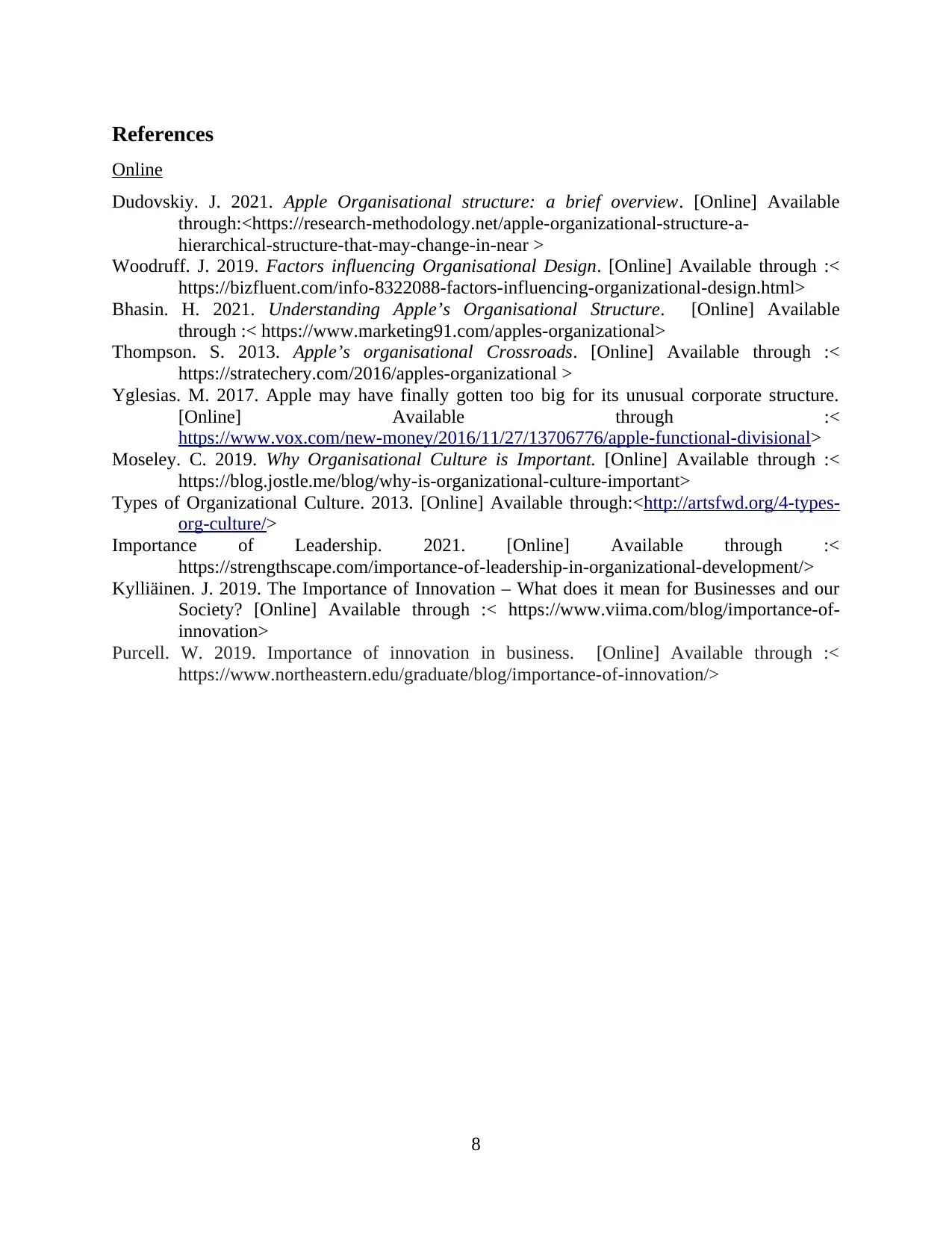
References
Online
Dudovskiy. J. 2021. Apple Organisational structure: a brief overview. [Online] Available
through:<https://research-methodology.net/apple-organizational-structure-a-
hierarchical-structure-that-may-change-in-near >
Woodruff. J. 2019. Factors influencing Organisational Design. [Online] Available through :<
https://bizfluent.com/info-8322088-factors-influencing-organizational-design.html>
Bhasin. H. 2021. Understanding Apple’s Organisational Structure. [Online] Available
through :< https://www.marketing91.com/apples-organizational>
Thompson. S. 2013. Apple’s organisational Crossroads. [Online] Available through :<
https://stratechery.com/2016/apples-organizational >
Yglesias. M. 2017. Apple may have finally gotten too big for its unusual corporate structure.
[Online] Available through :<
https://www.vox.com/new-money/2016/11/27/13706776/apple-functional-divisional>
Moseley. C. 2019. Why Organisational Culture is Important. [Online] Available through :<
https://blog.jostle.me/blog/why-is-organizational-culture-important>
Types of Organizational Culture. 2013. [Online] Available through:<http://artsfwd.org/4-types-
org-culture/>
Importance of Leadership. 2021. [Online] Available through :<
https://strengthscape.com/importance-of-leadership-in-organizational-development/>
Kylliäinen. J. 2019. The Importance of Innovation – What does it mean for Businesses and our
Society? [Online] Available through :< https://www.viima.com/blog/importance-of-
innovation>
Purcell. W. 2019. Importance of innovation in business. [Online] Available through :<
https://www.northeastern.edu/graduate/blog/importance-of-innovation/>
8
Online
Dudovskiy. J. 2021. Apple Organisational structure: a brief overview. [Online] Available
through:<https://research-methodology.net/apple-organizational-structure-a-
hierarchical-structure-that-may-change-in-near >
Woodruff. J. 2019. Factors influencing Organisational Design. [Online] Available through :<
https://bizfluent.com/info-8322088-factors-influencing-organizational-design.html>
Bhasin. H. 2021. Understanding Apple’s Organisational Structure. [Online] Available
through :< https://www.marketing91.com/apples-organizational>
Thompson. S. 2013. Apple’s organisational Crossroads. [Online] Available through :<
https://stratechery.com/2016/apples-organizational >
Yglesias. M. 2017. Apple may have finally gotten too big for its unusual corporate structure.
[Online] Available through :<
https://www.vox.com/new-money/2016/11/27/13706776/apple-functional-divisional>
Moseley. C. 2019. Why Organisational Culture is Important. [Online] Available through :<
https://blog.jostle.me/blog/why-is-organizational-culture-important>
Types of Organizational Culture. 2013. [Online] Available through:<http://artsfwd.org/4-types-
org-culture/>
Importance of Leadership. 2021. [Online] Available through :<
https://strengthscape.com/importance-of-leadership-in-organizational-development/>
Kylliäinen. J. 2019. The Importance of Innovation – What does it mean for Businesses and our
Society? [Online] Available through :< https://www.viima.com/blog/importance-of-
innovation>
Purcell. W. 2019. Importance of innovation in business. [Online] Available through :<
https://www.northeastern.edu/graduate/blog/importance-of-innovation/>
8
1 out of 8
Related Documents
Your All-in-One AI-Powered Toolkit for Academic Success.
+13062052269
info@desklib.com
Available 24*7 on WhatsApp / Email
![[object Object]](/_next/static/media/star-bottom.7253800d.svg)
Unlock your academic potential
Copyright © 2020–2025 A2Z Services. All Rights Reserved. Developed and managed by ZUCOL.





